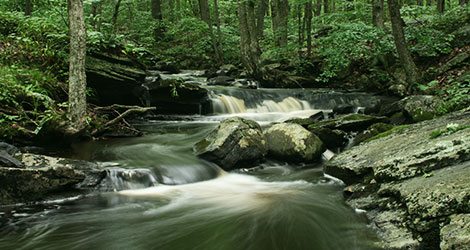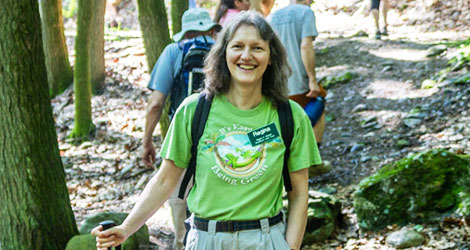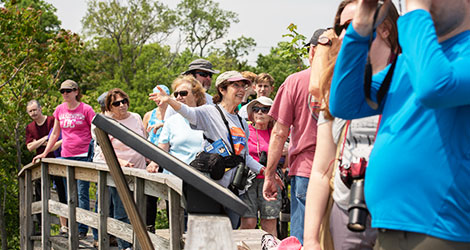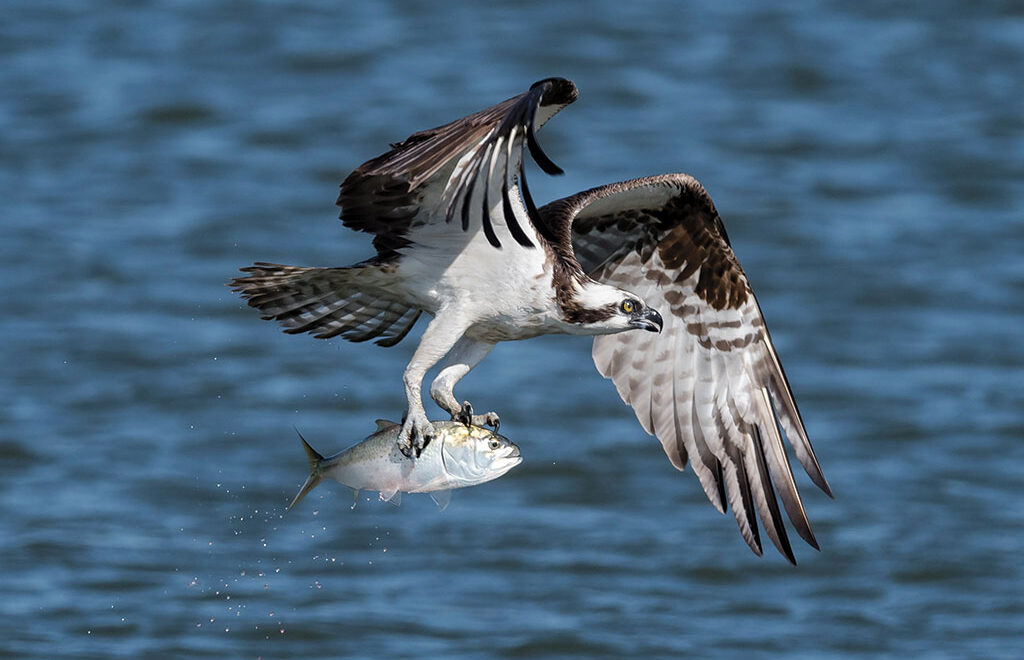
The Amazing Osprey
Once on the verge of extinction, ospreys are once again a common sight in Connecticut.
By Laurie D. Morrissey
Soaring high above the mouth of the Housatonic River, the osprey bides his time until he spots the ripple of a fin. Suddenly he bends his massive wings and spirals downward, plunges feet-first into the water, and disappears from view with a splash. He quickly surfaces with a wriggling fish, rises into the air with a hearty wing-shake to shed excess water, and flies off.

Photo by William Canosa
He makes it look easy—but there is a lot more to this fish-catching feat than meets the eye. This bird is so fine-tuned for its job that it has its own taxonomic genus and species: Pandion haliaetus. In addition to superior vision (an osprey can see fish underwater from as high as 130 feet), these birds have specialized talons that allow them to grasp a fish with two toes in front and two behind. The fourth toe can rotate to serve in either position, which enables the osprey to turn a fish so that it faces head-first, reducing air resistance during flight. The undersides of the toes are barbed for good grip. During dives, the bird’s nostrils close, and a third eyelid (the nictating membrane) closes to protect the eye.
Ospreys are no longer a rare sight in Connecticut, thanks to a concerted conservation effort that brought the bird back from the brink of extinction. The impressive raptor is commonly seen these days around coastal marshes, estuaries, reservoirs, and large lakes and rivers—wherever fish are abundant at shallow enough depths to catch. Its fish-heavy diet has led to its common nickname, fish hawk.
Ospreys return to New England in late March and early April after spending the winter as far south as Brazil and quickly begin nesting and raising the next generation. Most return to their previous year’s nest atop a tree, utility pole, or artificial platform. Added onto each year, an osprey’s stick nest is easily visible—and big enough that you could sit in it yourself if you could reach it.
With their nearly six-foot wingspans, white bellies, and white heads, ospreys are easy to identify. Among Connecticut raptors, only the bald eagle is larger. (The eagle’s white tail feathers also set it apart). The adult male osprey is brown above with slight streaking in a necklace shape on the breast. In flight, the bird’s wing position gives it a flattened M shape, with “wrists” held up and forward and outer wings held down and back. Another distinguishing feature is the broad black eye stripe that makes it look like it’s wearing a mask.
One of the state’s most avid osprey observers is Milan Bull, senior director of science and conservation with the Connecticut Audubon Society. His interest was piqued when he was a young boy on a Housatonic River flounder fishing expedition. His father excitedly pointed to an overhead osprey and told his son that it was a fortunate sighting.
“That bird will be extinct by the time you grow up,” he said. He was very nearly right.
“There were about a half dozen nesting pairs in Connecticut at that time. Now there are more than 900,” Bull says. That is nearly as many as there were in the 1940s, before the widespread use of chlorine-containing pesticides. Although there were warnings about the damaging effects of DDT in the 40s and 50s, it was the 1962 publication of Rachel Carson’s “Silent Spring” that sounded the alarm to the public. The United States banned the use of DDT a decade later.
“Insecticides like DDT got into the water and were ingested by small fish, which were ingested by bigger fish, which were taken by birds of prey like ospreys and eagles,” Bull explains. “Bioaccumulation in their eggshells caused trouble producing enough calcium. The shells began to thin in such a dramatic fashion that they cracked, and some didn’t have any shell at all.”
Without young birds replacing adults, ospreys declined severely. In Connecticut, restoration efforts began at the mouth of the Connecticut River, where fresh water enters salt water and supports a large population of filter-feeding herring called menhaden.
The species’ dramatic rebound is attributed to a combination of factors: the banning of DDT, habitat protection, monitoring and data collection efforts, and the construction of platforms in areas where natural nest sites are scarce. It is an impressive conservation success story, says Bull.
In addition to wildlife professionals, citizen scientists play a valuable role. In 2014, Connecticut Audubon launched a citizen science partnership called Osprey Nation to monitor the condition of nesting sites and gather data that give biologists a better understanding of the health of the osprey population. While the species’ comeback is excellent news, conservationists are on the alert for trends.
“If the osprey population begins to decline severely, we want to know when it’s happening and why,” says Milan Bull. “There was a slight decline in production last year, but we don’t know yet whether it’s statistically significant.”
Old Saybrook summer resident Anne McNulty has been a volunteer steward with Osprey Nation for six seasons, monitoring platforms in Old Saybrook and Old Lyme. Every spring, she looks forward to seeing adult ospreys arrive and begin the process of mating, building their nests, and incubating their eggs.
“I continue to thrill at seeing the first little featherless hatchlings’ heads pop up above the edge of the nest,” she says. “Then it gets exciting! Watching the nestlings go from down-covered to feathered, then start flapping their wings and finally taking flight—and seeing ‘Dad’ bring a fish to the platform. When I see ospreys fishing from the beach I always pause to watch as they hover and then make the plunge. I hold my breath to find out if they’re successful, and then watch to see if any gulls pursue them to steal their catch.”
Of course, not even the most talented fisherman is successful 100 percent of the time. Ornithologists have documented a success rate of about 25 to 70 percent—not bad, considering the odds. Osprey don’t waste any time, either: they spend an average of 12 minutes hunting before making a catch, and few anglers can beat that.
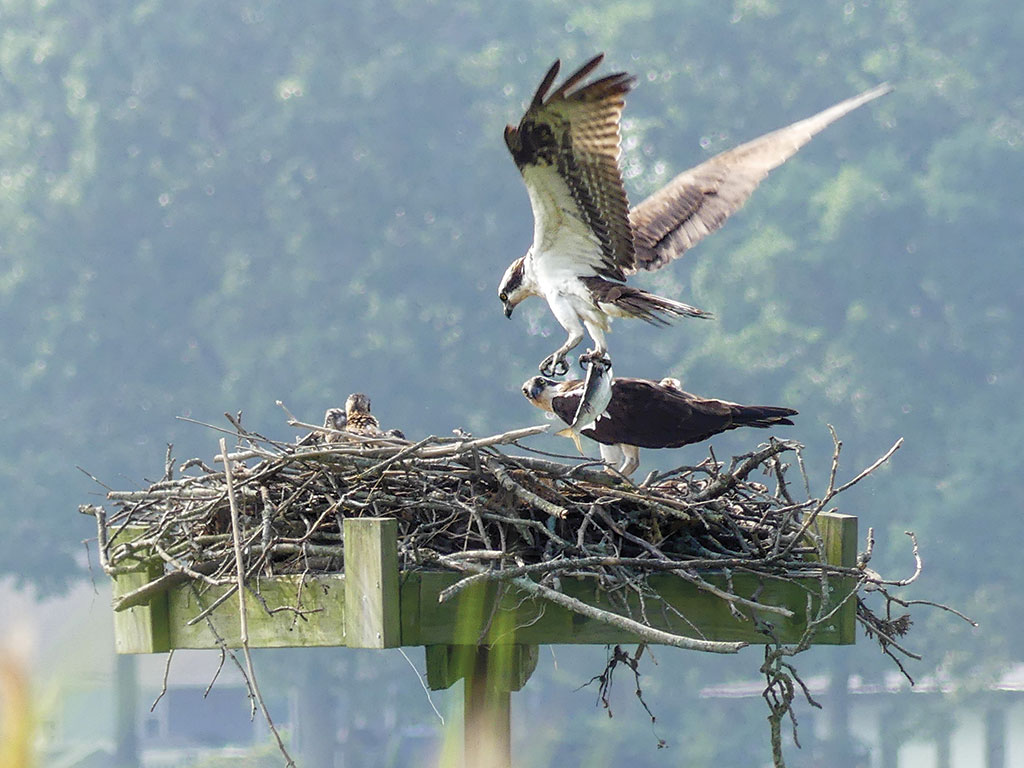
Photo by Anne McNulty
“I continue to thrill at seeing the first little featherless hatchlings’ heads pop up above the edge of the nest.”
Anne McNulty, Osprey Nation Volunteer
Over the past 10 years, about 700 trained Osprey Nation volunteers have contributed to the data collection effort documenting Connecticut’s osprey population. While not every nest is monitored, a high percentage are, according to Milan Bull. McNulty enjoys making a solid contribution to that effort. She also appreciates how much she learns in the process.
“Every year as I watch this drama, I find I have new questions about ospreys and their behavior,” she says. “Being a monitor also gives me a chance to help educate people who come by and ask what I’m doing.” One year, she knocked on a property owner’s door and asked permission to observe her nesting platforms from their yard. “For the next six years, I’ve had the opportunity to teach her about the marvelous happenings right before her eyes.”
Besides gathering data, volunteers fly into action when a nesting platform is destroyed by storms, as happened in February of 2021 in the tidal channel off Milford Point. It was the platform that held Connecticut Audubon’s Osprey Cam, which livestreams osprey activity to the delight of tens of thousands of viewers. Volunteers supplied both labor and materials.
The Osprey Cam is up and running, and so is this year’s army of volunteers. Your chance of seeing an osprey perform its fishing feat is very, very good.
For further information, including volunteer opportunities, about Connecticut’s ospreys, visit osprey@ctaudubon.org.
Laurie D. Morrissey is a New Hampshire-based writer of articles, essays, and poetry. Her work has appeared in Connecticut Woodlands since 2016, when she wrote about her father, state park ranger Bill Dougal. Her writing has appeared in Northern Woodlands, Art New England, New Hampshire Home, Appalachia, and numerous poetry journals.

